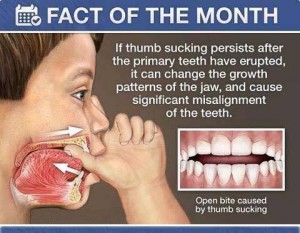Is thumb and finger sucking normal? 
Sucking is a healthy, normal and natural habit for infants. Most babies find comfort from sucking a thumb, finger or a pacifier.
When should I be concerned?
Thumb and finger sucking is not usually a concern until permanent teeth appear, unless some or all of the following factors are present:
- Forceful sucking.
- Sucking often during the day.
- Sucking throughout the night rather than just at bedtime.
- Sucking that has caused changes to the position of teeth, mouth or lips.
- Sucking along with tongue thrusting and speech difficulties.
What are the dental effects of thumb and finger sucking?
- The strong muscle action used for thumb or finger sucking can change the shape of the mouth and the position of the teeth and lips. This can lead to abnormal swallowing patterns, even when thumb or fingers are not present in the mouth.
- Repeated sucking after the four front permanent teeth grow in, makes these conditions worse and may require treatment and, in extreme cases, surgery.
- If, after the age of four, a child is unable to give up the habit, it is advisable to consult a dental professional.
Tips for parents
- Instead of scolding children for sucking, praise them when they are not.
- Spend lots of time with your child encouraging other uses of the hands such as puzzles, colouring, anything that will keep their hands busy.
- For habit-free days, offer a reward such as special time, a favourite video or activity.
- At naptime or bedtime, offer a child a small toy to hold and cuddle to replace the habit.
Pacifiers
- Sucking is a normal, natural habit for infants. A pacifier can satisfy this need and help to comfort and relax a baby. However, not all babies require a pacifier. It is better for a baby to suck on a pacifier than on a finger, toy or blanket.
- If you are breast-feeding, avoid using a pacifier until breast-feeding is going well, usually after eight weeks. This will help avoid nipple confusion as the sucking action required for breast-feeding and pacifiers is different.
- To prevent changes to the shape of a baby’s mouth, it is important to give a baby a pacifier that is soft enough to flatten out against the roof of the baby’s mouth during sucking. Continual use should be discouraged.
- When choosing a pacifier, look for one that is orthodontically approved. For safety reasons, one piece designs are recommended. Avoid attaching a string to the pacifier to prevent possible strangulation. Check the pacifier regularly to ensure it is in good condition. Tears, cracks or other signs of wear may make it unsafe for your baby to use.
Avoid coating pacifiers with sugar, honey or any sweet substance as this can cause baby’s teeth to decay. Honey and corn syrup may also contain spores that can cause food poisoning in infants under one year of age.
Sucking on fingers or thumbs is healthy and normal when children are infants. Most children stop somewhere between two and four years of age. The effects of thumb sucking are usually reversible up until the age of seven, because children still have their deciduous (baby) teeth. If thumb sucking continues beyond the age of seven, when the second teeth are coming through, permanent dental problems can occur.
Problems caused by thumb and finger sucking
Excessive thumb sucking may lead to:
- Buck teeth – for example, the front teeth may be pushed out of alignment. This can alter the shape of the face and lead to an open bite.
- A lisp – pre-school children who suck their fingers and thumbs can push their teeth out of their normal position. This interferes with the correct formation of certain speech sounds.
Helping children stop thumb and finger sucking
There are various things you can do to help your child stop thumb sucking. Focussing on the positives and rewarding your child are important. Depending on your child’s age and ability, you might like to try the following suggestions:
- Reward your child and offer encouragement – for example, with a hug or praise to reinforce their decision to stop the habit.
- Limit nagging – if children feel they are being nagged they will become defensive.
- Mark their progress on a calendar – for example, place a star or a tick for each period (such as a day or week) that the child does not suck their thumb or finger. Provide a special outing or a toy if the child gets through the period successfully.
- Encourage bonding – for example, with a special toy.
- Reminders – give your child a mitten to wear as a reminder not to suck, or place unpleasant tasting nail paint (available from chemists) on the fingers or thumb. Placing a plaster over the thumb at bedtime is another reminder.
- Offer distractions – while your child is watching TV, have toys available for children to play with. Sit with the child during this time and give a cuddle to help them not to suck. In the car, have toys available to keep them occupied.





